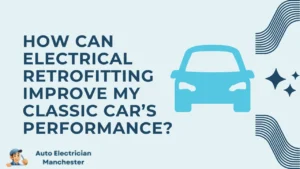
Electric vehicle (EV) retrofitting is an exciting innovation that empowers you to transform your cherished gasoline or diesel car into an eco-friendly electric powerhouse. This revolutionary technology grants a new lease on life to your car, reducing emissions and your environmental footprint.
As you embark on your EV retrofitting journey, two primary choices await you: Battery Electric Vehicle (BEV) and Hydrogen Fuel Cell Electric Vehicle (FCEV) conversions. Let’s delve deeper into these options to unveil the perfect fit for your needs.
BEV Retrofit: Power Up with Battery Performance
BEV retrofitting stands as the most prevalent approach in the EV conversion landscape. Here’s what this process entails:
Transformation from Combustion to Electric: The heart of your car undergoes a significant change. The gasoline or diesel engine, fuel tank, and exhaust system are meticulously removed, making way for a revolutionary new era.
Embracing Electric Power: In place of the traditional engine, a state-of-the-art electric motor is installed. This electric marvel becomes the driving force behind your car, drawing energy from a high-performance battery pack. A sophisticated control system is also integrated to ensure seamless operation and optimal power delivery.
Customizable Performance: BEV retrofit kits boast a spectrum of power levels, catering to diverse driving styles and preferences. You have the freedom to tailor the conversion to perfectly match your performance requirements, ensuring a thrilling electric driving experience.
While BEV conversions offer undeniable advantages, it’s essential to acknowledge a primary consideration: range anxiety. The driving range of a BEV retrofit is often limited by the capacity of the battery pack compared to a traditional gasoline tank. However, advancements in battery technology are continuously pushing the boundaries, offering promising solutions for extended travel distances in the near future.
FCEV Retrofit: Power of Hydrogen
The FCEV retrofit path presents a compelling alternative, especially for those seeking to conquer range anxiety. Here’s a glimpse into the world of hydrogen fuel cells:
Hydrogen Takes the Wheel: The conventional engine is replaced with a cutting-edge hydrogen fuel cell. This ingenious technology generates electricity through a captivating chemical reaction between hydrogen and oxygen. The electricity produced then powers the electric motor, propelling your car forward with clean energy.
Extended Range, Rapid Refueling: One of the most attractive aspects of FCEV conversions is their extended driving range, comparable to gasoline-powered vehicles. This translates to fewer stops at refueling stations, minimizing range anxiety and maximizing driving freedom. Additionally, refueling times for hydrogen vehicles are significantly faster than charging a BEV, offering a familiar experience for those accustomed to gasoline vehicles.
However, it’s crucial to acknowledge the current limitations of FCEV technology. The infrastructure for hydrogen refueling stations is still developing in many regions, potentially posing a challenge for widespread adoption.
Considerations for EV Retrofitting
Both BEV and FCEV conversions share some common aspects that require careful consideration:
Drivetrain Modifications: Transforming your car into an EV necessitates adjustments to its drivetrain. This might involve replacing the transmission entirely or adapting it to work seamlessly with the electric motor. These modifications are essential for ensuring optimal performance and a smooth driving experience.
Professional Expertise is Paramount: EV retrofitting is a complex undertaking that demands specialized knowledge and meticulous execution. Entrusting this process to a qualified and experienced technician is paramount. Their expertise guarantees safety, optimal performance, and a successful conversion that breathes new life into your beloved car.
Not One-Size-Fits-All: It’s important to remember that EV retrofitting might not be suitable for every vehicle. A thorough assessment of your car’s condition, compatibility with conversion kits, and economic feasibility is crucial before embarking on this exciting journey.
BEV vs. FCEV Retrofitting
While both BEV and FCEV conversions offer compelling pathways to electric mobility, distinctive factors influence the ideal choice for each driver. Let’s delve deeper into a side-by-side comparison to illuminate the best option for you:
Cost Considerations: BEV conversions typically boast a lower upfront cost compared to FCEV conversions. This is due, in part, to the more complex technology involved in hydrogen fuel cells. However, ongoing costs like electricity prices need to be factored into the equation for BEVs.
Environmental Impact: Both BEV and FCEV conversions significantly reduce tailpipe emissions, contributing to cleaner air and a healthier planet. However, the environmental impact of BEVs hinges on the source of electricity used for charging. If the electricity comes from renewable sources like solar or wind power, the overall environmental impact is minimized. FCEV conversions, on the other hand, produce zero tailpipe emissions, but the environmental footprint associated with hydrogen production needs to be considered.
Maintenance and Upkeep: Electric vehicles boast fewer moving parts compared to traditional gasoline cars. This translates to generally lower maintenance costs for both BEVs and FCEVs in the long run.
BEV vs. FCEV Retrofitting
Ultimately, the decision between BEV and FCEV retrofitting hinges on your individual priorities and driving habits. Consider these factors to make an informed choice:
Driving Range: If extensive driving range and minimal downtime for refueling are paramount, an FCEV conversion might be the ideal solution. However, if your daily commutes are shorter and access to charging infrastructure is convenient, a BEV might be a suitable and potentially more cost-effective option.
Environmental Friendliness: For those who prioritize minimizing the overall environmental impact, a BEV charged with renewable electricity offers a compelling solution. However, if tailpipe emissions are the primary concern, both BEVs and FCEVs excel in this regard.
Infrastructure Availability: The availability of hydrogen refueling stations in your region significantly impacts the practicality of an FCEV conversion. If hydrogen stations are scarce, a BEV with access to a robust charging network might be the more convenient choice.
Final Words
EV retrofitting is a burgeoning technology with immense potential. As battery technology advances, BEV conversions can expect to offer extended driving ranges, potentially mitigating range anxiety concerns. Furthermore, the development of hydrogen infrastructure is anticipated to accelerate in the coming years, making FCEVs a more viable option for a wider range of drivers.
EV retrofitting empowers you to reimagine the possibilities of your car. Whether you choose the performance and customizability of a BEV or the extended range and rapid refueling of an FCEV, you’re making a significant stride toward a cleaner, more sustainable future.
FAQ
Is EV retrofitting worth it?
The answer depends on your individual circumstances. Factors like the condition of your car, environmental consciousness, driving habits, and budget all play a role. Carefully weigh the pros and cons to determine if EV retrofitting aligns with your needs.

David Mack is a seasoned writer with a passion for the auto electrician niche. With years of hands-on experience and a knack for demystifying complex topics, David brings practical insights to his readers. Whether you’re a professional or a car enthusiast, his engaging articles offer valuable tips and trends in auto electrical systems.
